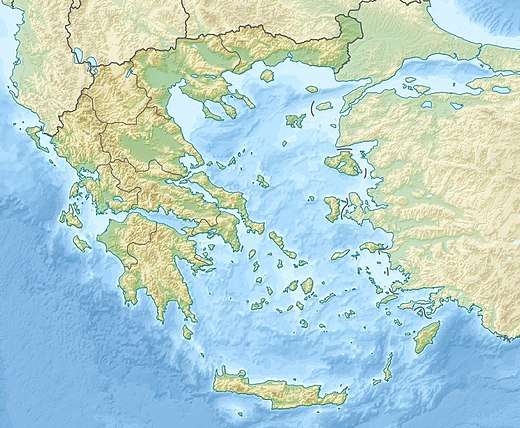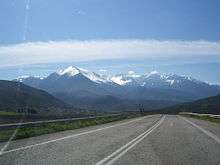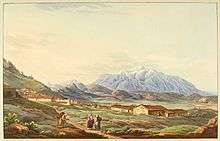Mount Parnassus
Mount Parnassus (/pɑːrˈnæsəs/; Greek: Παρνασσός, Parnassos) is a mountain of limestone in central Greece that towers above Delphi, north of the Gulf of Corinth, and offers scenic views of the surrounding olive groves and countryside. According to Greek mythology, this mountain was sacred to Dionysus and the Dionysian mysteries; it was also sacred to Apollo and the Corycian nymphs, and it was the home of the Muses. The mountain was also favored by the Dorians. It is suggested that the name derives from parnassas, the possessive adjective of the Luwian word parna meaning house, or specifically temple, so the name effectively means the mountain of the house of the god.[2]
| Parnassus | |
|---|---|
| Liakoura Παρνασσός | |
 Mount Parnassus | |
| Highest point | |
| Elevation | 2,457 m (8,061 ft) [1] |
| Prominence | 1,590 m (5,220 ft) [1] |
| Listing | Ultra |
| Coordinates | 38°32′09″N 22°37′27″E [1] |
| Geography | |
 Parnassus Location of Mount Parnassus in Greece | |
| Location | Delphi, Greece |
| Parent range | Pindus |
| Climbing | |
| Easiest route | Hike |
Geology and geography
Parnassus is one of the largest mountainous regions of Mainland Greece and one of the highest Greek mountains. It spreads over three municipalities, namely of Boeotia, Phthiotis and Phocis, where its largest part lies. Its altitude is 2,457 meters and its highest peak is Liakouras. To the Northeast it is connected to Giona and to the south with Kirphe. Its name is due to the homonymous hero of the Greek mythology, son of Cleopompus (or Poseidon) and Cleodora, who had built on the mountain a city which was destroyed in the Deluge of Deukalion. Etymological analysis, however, shows a prehellenic origin of the name, relating it to the Pelasgians, and it appears to be from the Anatolian language Luwian.[2] The mountain is delimited to the east by the valley of the Boeotian Kephissus and to the West by the valley of Amfissa. The geological particularity of Parnassus is its rich deposits of bauxite, which has led to their systematic mining since the end of the 1930s, resulting in ecological damage to part of the mountain.[3]
Mythology
.svg.png)
Mount Parnassus is named after Parnassos, the son of the nymph Kleodora and the man Kleopompus. A city, of which Parnassos was leader, was flooded by torrential rains. The citizens ran from the flood, following wolves' howling, up the mountain slope. There the survivors built another city, and called it Lykoreia, which in Greek means "the howling of the wolves." While Orpheus was living[4] with his mother and his eight beautiful aunts on Parnassus, he met Apollo who was courting the laughing muse Thalia. Apollo became fond of Orpheus and gave him a little golden lyre, and taught him to play it. Orpheus's mother taught him to make verses for singing. As the Oracle of Delphi was sacred to the god Apollo, so did the mountain itself become associated with Apollo. According to some traditions, Parnassus was the site of the fountain Castalia and the home of the Muses; according to other traditions, that honor fell to Mount Helicon, another mountain in the same range. As the home of the Muses, Parnassus became known as the home of poetry, music, and learning.
Parnassus was also the site of several unrelated minor events in Greek mythology.
- In some versions of the Greek flood myth, the ark of Deucalion comes to rest on the slopes of Parnassus. This is the version of the myth recounted in Ovid's Metamorphoses.
- Orestes spent his time in hiding on Mount Parnassus.
- Parnassus was sacred to the god Dionysus.
- The Corycian Cave, located on the slopes of Parnassus, was sacred to Pan and to the Muses.
- In Book 19 of The Odyssey, Odysseus recounts a story of how he was gored in the thigh during a boar hunt on Mount Parnassus in his youth.
Parnassus was also the home of Pegasus, the winged horse of Bellerophon.
As metaphor

This relation of the mountain to the Muses offered an instigation to its more recent "mystification", with the poetic-artistic trend of the 19th century called "Parnassism". The Parnassic movement was established in France in the decade 1866–1876 as a reaction to Romanticism with a return to some classicistic elements and belief in the doctrine "Art for the Art", first expressed by Theophile Gautier. The periodical Modern Parnassus issued for the first time by Catul Mendes and Xavier Ricard contained direct references to Mt. Parnassus and its mythological feature as habitation of the Muses. The Parnassists, who did not exceed a group of twenty poets, exercised a relatively strong influence on the cultural life of Paris, particularly due to their tenacity on perfection of rhyme and vocabulary. Parnassism influenced several French poets, but it also exercised an influence on Modern Greek poets, particularly Kostis Palamas and Gryparis. The name of the mountain (Mont Parnasse) was also given to a quarter of Paris on the left bank of the Seine, where artists and poets used to gather and recite their poems in public. Montparnasse is nowadays one of the most renowned quarters of the city and in its cemetery many personalities of the arts and culture are buried.[3]
Parnassus figures earlier in Jonathan Swift's The Battle of the Books (1697) as the site of an ideological war between the ancients and the moderns.
Cultural Change
In 1995, Roland S. Moore, of the Prevention Research Center in the US, conducted a study on how the advent of tourism influenced cultural change in the region. The research focused primarily on changes in alcohol use and the structure of the household. Prior to the 1970s and the boom of Greek tourism, drinking was done primarily by men. As time went on, a greater variety of liquor became available, leading to greater consumption, particularly by women, who were more likely to work in the hospitality sector where drinks were readily available. The role of patriarchal breadwinner diminished, replaced by a more democratic familial structure.
National Park
The significant biodiversity, both in flora and in fauna, led the authorities to the establishment of the National Park of Parnassus in 1938, the year when the systematic mining of bauxite started. The Park comprises a landscape of 15,000 hectares (36,000 acres) spreading on the mountainous region between Delphi, Arachova and Agoriani. Among the endemic flora species under protection are the Cephalonian fir tree and the Parnassian peony (Paeonia parnassica). In the Park sojourn prey birds and wolves, boars, badgers and weasels.

Parnassos Ski Resort

The slopes of Mount Parnassus are composed of two ski sections, Kellaria and Fterolakka, which together make up the largest ski center in Greece. A smaller ski center (only two drag lifts) called Gerontovrahos is across a ridge from Kellaria. Parnassus is mined for its abundant supply of bauxite which is converted to aluminium oxide and then to aluminium.[5]
The construction of the ski resort started in 1975 and was completed in 1976, when the first two drag lifts operated in Fterolaka. In 1981 the construction of a new ski area was completed in Kelaria, while in winter season 1987–1988 the chair lift Hermes started operating and connected the two ski areas. Both ski resorts continued expanding and in 1993 the first high-speed quad in Greece was installed, named Hercules. In 2014–2015 two new hybrid lifts were installed along with a new eight-seater, replacing the old infrastructure.
Today the Ski Center operates with 16 lifts, two hybrid ski lifts which combine an eight-seater Cabin and a six-seater chair, an eight-seater Cabin, a 4-seater chair lift, a 2-seater chair lift, 6 drag lifts and four baby lifts. The ski center boasts 25 marked ski runs and about 15 ski routes of 36 km (22 mi) total length while the longest run is 4 km (2 mi).
See also
References
- "Europe Ultra-Prominences" Listed as "Liakoura". Peaklist.org. Retrieved 2012-02-19.
- Palmer, Leonard R., 1961, "Mycenaeans and Minoans", pp.241-2
- Racot, A., 1967,"Les Parnassiens, introduction and commentaries by M. Pakenham", presented by Louis Forestier, Aux Lettres modernes: collection avant-siècle
- The Greek Gods by Hoopes And Evslin , ISBN 0-590-44110-8, ISBN 0-590-44110-8, 1995, page 77 His father was a Thracian king; His mother the muse Calliope. For a while he lived on Parnassus with his mother and his eight beautiful aunts, and there met Apollo who was courting the laughing muse Thalia. Apollo was taken with Orpheus, gave him his little golden lyre, and taught him to play. His mother taught him to make verses for singing.
- The Parnassos Ski Centre Archived 2006-08-22 at the Wayback Machine
External links
| Wikimedia Commons has media related to Mount Parnassus. |
- Greek Mountain Flora
- "Óros Parnassos, Greece" on Peakbagger
- . Encyclopædia Britannica (11th ed.). 1911.